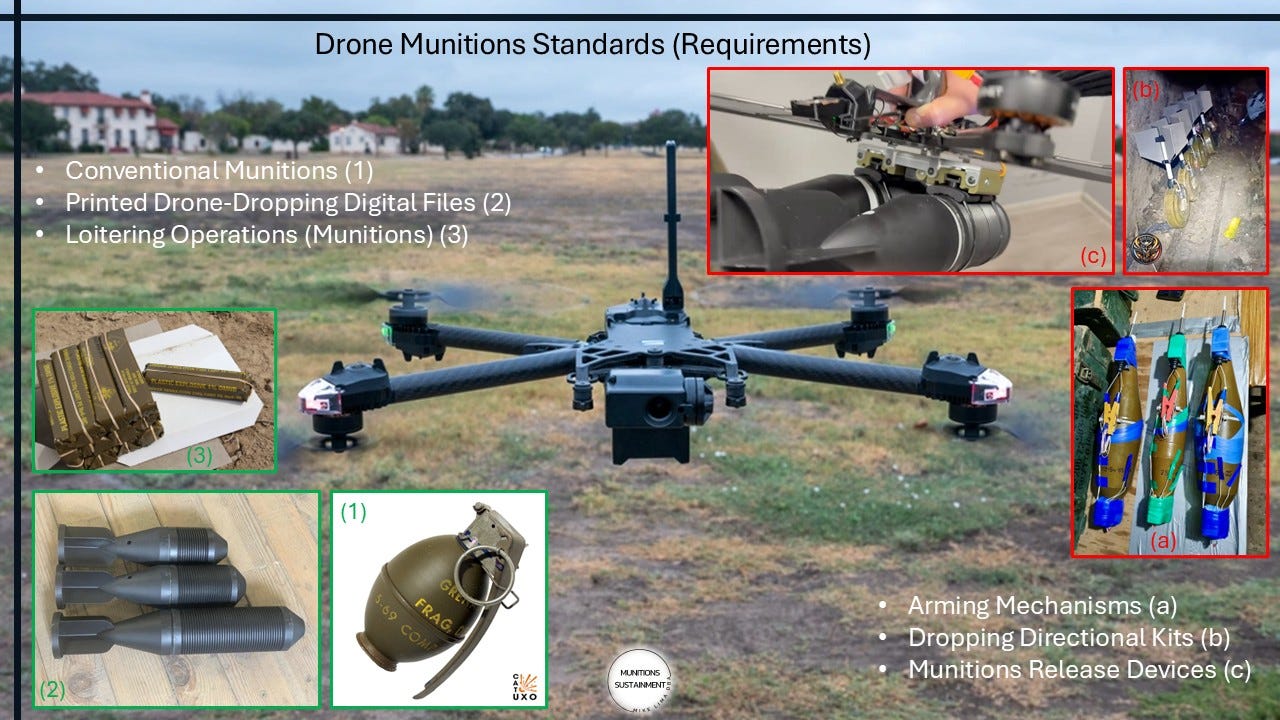Main Image: Tech. Sgt. Sean Carnes, Air Force Public Affairs Agency small, unmanned aircraft system program manager, flies a sUAS during currency training at Joint Base San Antonio – Fort Sam Houston, Texas, Oct. 24, 2024. AFPAA oversees the sUAS program for the USAF public affairs career field ensuring new directives, rules or updates get distributed to anyone else using a drone program. (U.S. Air Force photo by Joshua J. Garcia)
The increasing use of drones for military applications necessitates robust standards for drone munitions, including loitering, drone-dropping, and drone-firing operations. Standards are needed to ensure safety, accuracy, and effectiveness while minimizing collateral damage without removing the ability to give warfighters a leading edge in the fight to be creative and innovate as required. A general overview of key standard requirements that need consideration includes the following.
The starting standard begins with the combination of approved drones and munitions. Then, select 1 through 3 and add a through c.
Conventional Munitions, Munitions Drone-Dropping Digital Files, and Munitions for Loitering Operations :
Conventional Munitions: Utilizing conventional munitions in drone delivery systems requires careful consideration of factors like explosive yield, fragmentation patterns, and blast effects. This ensures appropriate munition-to-drone selection for possible targets and minimizes unintended harm.
Printed Drone-Dropping Digital Files: Accurate and reliable digital files for drone-dropping operations are crucial. These files must contain 3D drone-specific munition models, enabling detailed analysis of their shape, dimensions, and internal components. Robust data security measures are essential to prevent unauthorized access and manipulation of these files.
Loitering Operations (Munitions): Loitering munitions are designed to remain airborne and engage targets of opportunity, demanding unique safety and operational considerations. The selected drone must have robust flight control systems to accompany the selected munitions to employ.
Arming Mechanisms, Dropping Directional Kits, and Munitions Release Devices:
a) The Arming mechanisms for drone munitions are critical safety features that prevent accidental detonation during handling, transport, and flight. Arming mechanisms must be highly reliable and incorporate fail-safe features to prevent inadvertent detonation.
b) Dropping Directional Kits: These kits ensure munitions achieve the desired impact angle and reduce dispersion. Standards must address factors like kit design, materials, and deployment mechanisms to ensure consistent and reliable performance.
c) Munitions Release Devices: These devices must be designed to reliably and accurately release munitions from the drone platform. Factors such as release timing, accuracy, and the ability to accommodate various munition types must be carefully considered in the design and testing
Note: Each category is not singular and may be interdependent with others.
Disclaimer: This post provides a general overview and does not constitute legal or technical advice, and views are my own and do not necessarily represent the views of employer.
Images Credit
DVIDS - Defense Visual Information Distribution Service, https://www.dvidshub.net/
Steel Hornets, https://www.facebook.com/steelhornets2022
Roy @GrandpaRoy2, https://x.com/GrandpaRoy2
EOD205 @eod205, https://x.com/eod205
CATUXO, https://cat-uxo.com/




